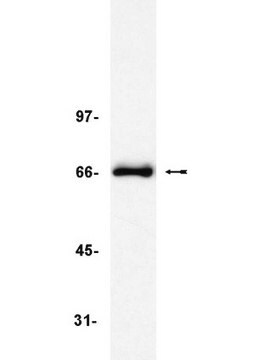PLA0144
Rabbit anti-TRF2 Antibody, Affinity Purified
Powered by Bethyl Laboratories, Inc.
Sinonimo/i:
TRBF2, TRF2, TTAGGG repeat-binding factor 2, telomeric DNA-binding protein, telomeric repeat binding protein 2
About This Item
Prodotti consigliati
Origine biologica
rabbit
Livello qualitativo
Forma dell’anticorpo
affinity purified immunoglobulin
Tipo di anticorpo
primary antibodies
Grado
Powered by Bethyl Laboratories, Inc.
Reattività contro le specie
human
tecniche
immunoprecipitation (IP): 2- 5 μg/mg
western blot: 1:2,000- 1:10,000
Numero d’accesso
NP_005643.1
Condizioni di spedizione
wet ice
Temperatura di conservazione
2-8°C
Informazioni sul gene
rabbit ... TRF2(7014)
Descrizione generale
Immunogeno
Azioni biochim/fisiol
Stato fisico
Altre note
Esclusione di responsabilità
Non trovi il prodotto giusto?
Prova il nostro Motore di ricerca dei prodotti.
Codice della classe di stoccaggio
12 - Non Combustible Liquids
Classe di pericolosità dell'acqua (WGK)
WGK 1
Punto d’infiammabilità (°F)
Not applicable
Punto d’infiammabilità (°C)
Not applicable
Scegli una delle versioni più recenti:
Certificati d'analisi (COA)
Ci dispiace, ma al momento non ci sono COA disponibili online per questo prodotto.
Se ti serve aiuto, non esitare a contattarci Servizio Clienti
Possiedi già questo prodotto?
I documenti relativi ai prodotti acquistati recentemente sono disponibili nell’Archivio dei documenti.
Il team dei nostri ricercatori vanta grande esperienza in tutte le aree della ricerca quali Life Science, scienza dei materiali, sintesi chimica, cromatografia, discipline analitiche, ecc..
Contatta l'Assistenza Tecnica.





